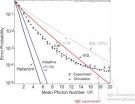(Press-News.org) VIDEO:
This movie shows two simulations of planetary system disruption by galactic disturbances to wide binary stars. On the left is a zoomed-out view showing the orbit of a hypothetical 0.1...
Click here for more information.
TORONTO, ON – An international team of astrophysicists has shown that planetary systems with very distant binary stars are particularly susceptible to violent disruptions, more so than if they had stellar companions with tighter orbits around them.
Unlike the Sun, many stars are members of binary star systems – where two stars orbit one another – and these stars' planetary systems can be altered by the gravity of their companion stars. The orbits of very distant or wide stellar companions often become very eccentric – ie. less circular – over time, driving the once-distant star into a plunging orbit that passes very close to the planets once per orbital period. The gravity of this close-passing companion can then wreak havoc on planetary systems, triggering planetary scatterings and even ejections.
"The stellar orbits of wide binaries are very sensitive to disturbances from other passing stars as well as the tidal field of the Milky Way," said Nathan Kaib, lead author of a study published today in Nature describing the findings. "This causes their stellar orbits to constantly change their eccentricity – their degree of circularity. If a wide binary lasts long enough, it will eventually find itself with a very high orbital eccentricity at some point in its life."
When a wide binary orbit becomes very eccentric, the two stars will pass very close together once per orbit on one side of the orbital ellipse, while being very far apart on the other side of the ellipse. This can have dire consequences for planets in these systems since the gravity of a close-passing star can radically change planetary orbits around the other star, causing planets to scatter off of one another and sometimes get ejected to interstellar space.
Kaib, a postdoctoral fellow in the Center for Interdisciplinary Exploration and Research in Astrophysics (CIERA) and the Department of Physics and Astronomy at Northwestern University and a National Fellow in the Canadian Institute for Theoretical Astrophysics at the University of Toronto, conducted computer simulations of the process with Queen's University physics professor Martin Duncan and Sean N. Raymond, a researcher at the University of Bordeaux and the Centre national de la recherche scientifique in France. They added a a hypothetical wide binary companion to the Earth's solar system which eventually triggered at least one of four giant planets (Jupiter, Saturn, Uranus and Neptune) to be ejected in almost half of the simulations.
"This process takes hundreds of millions of years if not billions of years to occur in these binaries. Consequently, planets in these systems initially form and evolve as if they orbited an isolated star," said Kaib, who will present the findings this week at the 221st meeting of the American Astronomical Society in Long Beach, California. "It is only much later that they begin to feel the effects of their companion star, which often times leads to disruption of the planetary system."
"We also found that there is substantial evidence that this process occurs regularly in known extrasolar planetary systems," said Duncan. "Planets are believed to form on circular orbits, and they are only thought to attain highly eccentric orbits through powerful and/or violent perturbations. When we looked at the orbital eccentricities of planets that are known to reside in wide binaries, we found that they are statistically more eccentric than planets around isolated stars like our Sun. "
The researchers believe this is a telltale signature of past planetary scattering events, and that those with eccentric orbits are often interpreted to be the survivors of system-wide instabilities.
"The eccentric planetary orbits seen in these systems are essentially scars from past disruptions caused by the companion star," said Raymond.
The researchers note that this observational signature could only be reproduced well when they assumed that the typical planetary system extends from its host star as much as 10 times the distance between the Earth and the Sun. Otherwise, the planetary system is too compact to be affected by even a stellar companion on a very eccentric orbit.
"Recently, planets orbiting at wide distances around their host stars have been directly imaged. Our work predicts that such planets are common but have so far gone largely undetected," says Duncan.
###
Note to media: Visit www.artsci.utoronto.ca/main/media-releases/wide-binary-stars-study to view a simulation of the process described here.
MEDIA CONTACTS:
Nathan Kaib
Center for Interdisciplinary Exploration and Research in Astrophysics, Northwestern University & Canadian Institute for Theoretical Astrophysics, University of Toronto
440-290-9387 (cell)
847-467-3017 (office)
nathan.kaib@northwestern.edu
Sean Bettam
Communications, Faculty of Arts & Science
University of Toronto
s.bettam@utoronto.ca
416-946-7950
END
Technologically valuable ultrastable glasses can be produced in days or hours with properties corresponding to those that have been aged for thousands of years, computational and laboratory studies have confirmed.
Aging makes for higher quality glassy materials because they have slowly evolved toward a more stable molecular condition. This evolution can take thousands or millions of years, but manufacturers must work faster. Armed with a better understanding of how glasses age and evolve, researchers at the universities of Chicago and Wisconsin-Madison raise the possibility ...
Cleaning up mercury pollution and reducing prenatal exposure to the neurotoxin methylmercury (MeHg) could save the European Union €10,000 million per year, finds a new study published in BioMed Central's open access journal Environmental Health. New estimates suggest that between 1.5 and 2 million children in the EU are born each year with MeHg exposures above the safe limit of 0.58µg/g and 200,000 above the WHO recommended maximum of 2.5µg/g.
While some mercury occurs naturally in the environment for example from volcanic eruptions or forest fires, most is generated ...
"That's not what I meant": human communication is fraught with misinterpretation. Written out in longhand, words and letters can be misread. A telegraph clerk can mistake a dot for a dash. Noise will always be with us, but at least a new JQI (*) device has established a new standard for reading quantum information with a minimum of uncertainty.
Success has come by viewing light pulses not with a single passive detector with but an adaptive network of detectors with feedback. The work on JQI's new, more assured photonic protocol was led by Francisco Becerra ...
DEERFIELD, IL-Beak shape variation in Darwin's finches is a classic example of evolutionary adaptation, with beaks that vary widely in proportions and shape, reflecting a diversity of ecologies. While living birds have a beak to manipulate their food, their fossil bird ancestors had teeth. Now a new fossil discovery shows some fossil birds evolved teeth adapted for specialized diets.
A study of the teeth of a new species of early bird, Sulcavis geeorum, published in the latest issue of the Journal of Vertebrate Paleontology, suggests this fossil bird had a durophagous ...
New research reveals a shared genetic susceptibility to epilepsy and migraine. Findings published in Epilepsia, a journal of the International League Against Epilepsy (ILAE), indicate that having a strong family history of seizure disorders increases the chance of having migraine with aura (MA).
Medical evidence has established that migraine and epilepsy often co-occur in patients; this co-occurrence is called "comorbidity." Previous studies have found that people with epilepsy are substantially more likely than the general population to have migraine headache. However, ...
PHILADELPHIA (January 7, 2013)—Fox Chase Cancer Center, a National Cancer Institute-designated Comprehensive Cancer Center, is now offering patients with advanced cancer a cutting-edge clinical test that will provide them with a unique blueprint of their cancer genes.
The new clinical test, known as CancerCode-45TM, evaluates an individual's tumor for genetic alterations in a select group of 45 genes and gives physicians the opportunity to look at the alterations and be even more precise when choosing a course of treatment. The test is being offered through the Cancer ...
BLOOMINGTON and INDIANAPOLIS, Ind. -- Under the law, whistle-blowers are supposed to be protected from direct reprisals on the job, including discrimination. But what if they and their actions becomes the subject of a widely distributed email? Is that a form of retaliation?
Two professors at Indiana University's Kelley School of Business set out to answer that question and determine when public disclosure of the whistle-blower's identity -- like in an email -- is sufficient to support such a claim, in a paper that has been accepted for publication in North Carolina Law ...
VIDEO:
Breastfeeding advice has been passed down for generations and many new mothers are faced with a lot of information to sort through. Researchers at Ohio State University Wexner Medical Center...
Click here for more information.
COLUMBUS, Ohio – Breastfeeding can be a difficult time for both mother and baby, so using cabbage leaves and tea bags to ease pain or eating oatmeal to increase milk production are among the folk remedies that women pass along to new mothers ...
Researchers at Yale School of Medicine have identified a key link between stem cell factors that fuel ovarian cancer's growth and patient prognosis. The study, which paves the way for developing novel targeted ovarian cancer therapies, is published online in the current issue of Cell Cycle.
Lead author Yingqun Huang, M.D., associate professor in the Department of Obstetrics, Gynecology & Reproductive Sciences, and her colleagues have demonstrated a connection between two concepts that are revolutionizing the way cancer is treated.
First, the "cancer stem cell" idea ...
Versatile and responsive to management, corn is grown throughout the world for everything from food to animal feed to fuel. A new use for corn could soon join that list, as researchers in China investigate the crop's ability to induce "suicidal germination" in a devastating parasitic weed.
Known commonly as sunflower broomrape, the weed causes extensive damage to vegetable and row crops in Asia, Africa, and southern Eastern Europe. Lacking chlorophyll, it is a parasite and completely dependent on a host plant for water and nutrients. An infestation of broomrape in sunflower ...




